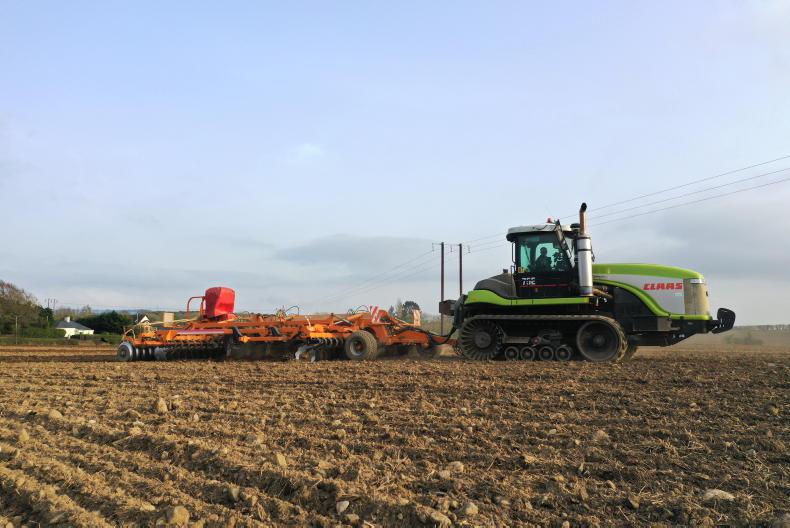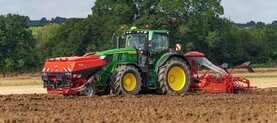Tillage farming on the outskirts of Naas, Co Kildare, Garrett Headon farms alongside his father Eugene. The duo also run a silage contracting business.
But for these men, it’s not all about new and shiny machinery (especially when it comes to tractors), but instead reliability, performance and, importantly, an investment that will retain as much value as possible.
Until 2019, primary cultivations were done using two tractors and two Simba Solo 300 3m stubble cultivators.
Looking to cut back on the running costs associated with two tractors and cultivators, as well as reducing labour, the decision was made to buy one larger tractor and a bigger cultivator.
Tracks over wheels
The obvious thing to do, Garrett said, was to go down the route of another Challenger.
“For the previous seven years, we had a 270hp Claas Challenger 55. We originally went for a crawler after debating whether to buy it or an articulated Ford FW-60. It was initially bought to furrow press with a Cross 5m double press.
“The crawler sits up on the soil and grips, yet it doesn’t sink in like a wheeled tractor. It also pulled one of the 3m Simba Solos.”
Origins
“It came from Houlgrave’s in Lincolnshire in 2011, a well-known hiring agent for Challenger crawlers. There were no machines for sale here in Ireland due to their scarcity.
“Over the years, the 55 served us well, but, regrettably, it had to go and make way for a larger replacement. We sold the tractor to a farmer in north Dublin.”
Garrett happened to spot a larger model 340hp 75E Claas Challenger for sale where the previous Challenger was bought from.
“Ian had a 2002 75E advertised which was prepped for hire, but never went on hire. We bought the tractor and then bought the 7m Simba SL 700. For a short period we got to work the 55 and 75E together for a few weeks before it was sold.”
Garrett explained that the Challenger stacked up from a financial point of view and offered the most horsepower for their budget.
“To buy a new 340hp tractor would be a massive investment. What’s more, this would be the tractor doing no more than 300 hours annually.
“Not many other tasks require such power, apart from using it on a wet year to pull the Horsch 6m KR drill.”
Track units
The 75E, unlike the previous 55, is a flat-tracked model. The 35, 45 and 55 models were based on the Ford Genesis tractors, so they had larger rear-drive wheels, which were later adopted on to the larger-framed MT Series.
The smaller-diameter flat-track drive wheels had limited power transfer over 400hp.
The Headons’ current 75E is fitted with the heavy-duty cast driver wheels and extreme-duty 635mm-wide tracks, which Garrett explains contain more steel over the standard tracks.
Each track has an inflatable air bag unit which provides a degree of suspension via the four mid-rollers on either side.
On this generation of Challenger, both tracks tension in tandem via two large hydraulic cylinders. The only downside here is that in the unlucky event of damaging one track, the two will need to be replaced for even tensioning.
Engine and transmission
The 19-year-old Claas Challenger 75E is fitted with a 10.3l six-cylinder Caterpillar diesel engine, which churns out a raw 340hp. Garrett noted how the engine, albeit not the driest in the world, has been bulletproof.
Coupled to the power plant is a 10F X 2R powershift transmission, which is renowned as being faultless. The transmission and back end have separate oil supplies, so oil contamination is impossible.
Unlike your typical tractor fitted with an accelerator, the large Challengers are fitted with a decelerator.
“It’s a great job once used to. Once I set the working revs (roughly 1,800rpm), when I come to the headland I use the decelerator to reduce engine revs and turn before engaging working position again. I lift off the decelerator and resume working revs. It means that once the hand throttle is set, it is not moved.”
Regardless of the outside temperature or engine load, the Challenger never fails to stay cool, Garrett said. It is fitted with a large cooling pack with a rather unusual folded core design for increased surface area, similar to that found in a dozer.
Cab and build
The Headons’ Claas Challenger 75E is in immaculate original condition. The only other things Garrett pointed out that aren’t original are the Eurotrak stainless steel exhaust and the larger neatly fabricated toolbox. Other than this, he replaced the grille lights with LEDs.
Garrett likes the fact that everything on the tractor is straightforward and mechanical, with minimal electrics.
“You’d know it’s an American-built machine sitting in it. Everything is that bit further away in terms of controls compared to the Ford cab on the previous 55 model. It is also a bit louder too, but I find it a comfy cab.
“They say the Challengers are built for a life span of 50,000 hours and I can see why. By the quality in its making, you know it’ll last.”
Fully ballasted up, Garrett says that the 75E weighs 18t excluding the 11.5t Simba SL cultivator.
“With the tractor spending over 90% of its time in the field, tracks definitely make sense for that weight. It took some getting used to the way a crawler drives and handles, especially on headlands. They can be very harsh on implements if care isn’t taken.”
Other working classics in the fleet
The love for modern classics is evident throughout the fleet and partly explains the reasons for owning a classic crawler.
Although tractors are bought new and secondhand, Garrett and Eugene have a serious eye for detail and have all their tractors in immaculate condition.
Other tractors currently in the yard include the following Massey Fergusons: 6495, 8280, 8480, 7718 and a 7720. There is also a New Holland TM165 and a Fendt 820, which was recently added.
Up until recently, the men had an immaculate Ford 8970 which they parted ways with earlier in spring.
Challenger history
Challenger was established in the late 1980s. The range was manufactured by Caterpillar in Illinois, US.
Caterpillar offered 17 variations from the 65 model in 1986 up to its final four models (65E, 75E, 85E, 95E) in 2001.
Horsepower ranged from the 210hp 35 machine up the 410hp 95E. Caterpillar has used the same general style since about 1994.
Challenger was marketed in Europe under the Claas livery from around 1997. Caterpillar sold the Challenger brand to AGCO in 2002.
Today, Challenger continues as a brand under the AGCO umbrella. In 2017, AGCO incorporated Challenger tractors into the Fendt portfolio.
Verdict
“The Challenger crawlers are great tools. If it’s value or horsepower for money you’re after, coupled with reliability, you couldn’t go wrong.
“Now in the third season, we’ve clocked up just over 650 hours, leaving it with 8,500 hours on the clock. All we’ve done under the bonnet was replace the water pump, as it was leaking, and replace the alternator.
“Paired with the Simba SL 700, it’s a much quicker way of getting through work with less resources. The diesel tank holds 1,050l and, depending on conditions, it could burn through 50-55l/hour. With the SL 700, in good going you’d get through roughly 10ac/hr.
“They’re not everyone’s cup of tea, but we can’t fault them, regardless of age. We see them as proper workhorses, purely mechanical from front to back. Things like the manual spools, lack of electronics and all the modern refinements are what we like about it.”
Spec
Model: 75E.Engine: 340hp Caterpillar 10.3l six-cylinder.Transmission: 30km/h powershift (10 forward and 2 reverse).Hydraulics: 152l/min. Unladen weight: 15,785kg.Fuel capacity: 1,060l.Production run: 1998-2001.Manufactured: In Illinois, US.
Tillage farming on the outskirts of Naas, Co Kildare, Garrett Headon farms alongside his father Eugene. The duo also run a silage contracting business.
But for these men, it’s not all about new and shiny machinery (especially when it comes to tractors), but instead reliability, performance and, importantly, an investment that will retain as much value as possible.
Until 2019, primary cultivations were done using two tractors and two Simba Solo 300 3m stubble cultivators.
Looking to cut back on the running costs associated with two tractors and cultivators, as well as reducing labour, the decision was made to buy one larger tractor and a bigger cultivator.
Tracks over wheels
The obvious thing to do, Garrett said, was to go down the route of another Challenger.
“For the previous seven years, we had a 270hp Claas Challenger 55. We originally went for a crawler after debating whether to buy it or an articulated Ford FW-60. It was initially bought to furrow press with a Cross 5m double press.
“The crawler sits up on the soil and grips, yet it doesn’t sink in like a wheeled tractor. It also pulled one of the 3m Simba Solos.”
Origins
“It came from Houlgrave’s in Lincolnshire in 2011, a well-known hiring agent for Challenger crawlers. There were no machines for sale here in Ireland due to their scarcity.
“Over the years, the 55 served us well, but, regrettably, it had to go and make way for a larger replacement. We sold the tractor to a farmer in north Dublin.”
Garrett happened to spot a larger model 340hp 75E Claas Challenger for sale where the previous Challenger was bought from.
“Ian had a 2002 75E advertised which was prepped for hire, but never went on hire. We bought the tractor and then bought the 7m Simba SL 700. For a short period we got to work the 55 and 75E together for a few weeks before it was sold.”
Garrett explained that the Challenger stacked up from a financial point of view and offered the most horsepower for their budget.
“To buy a new 340hp tractor would be a massive investment. What’s more, this would be the tractor doing no more than 300 hours annually.
“Not many other tasks require such power, apart from using it on a wet year to pull the Horsch 6m KR drill.”
Track units
The 75E, unlike the previous 55, is a flat-tracked model. The 35, 45 and 55 models were based on the Ford Genesis tractors, so they had larger rear-drive wheels, which were later adopted on to the larger-framed MT Series.
The smaller-diameter flat-track drive wheels had limited power transfer over 400hp.
The Headons’ current 75E is fitted with the heavy-duty cast driver wheels and extreme-duty 635mm-wide tracks, which Garrett explains contain more steel over the standard tracks.
Each track has an inflatable air bag unit which provides a degree of suspension via the four mid-rollers on either side.
On this generation of Challenger, both tracks tension in tandem via two large hydraulic cylinders. The only downside here is that in the unlucky event of damaging one track, the two will need to be replaced for even tensioning.
Engine and transmission
The 19-year-old Claas Challenger 75E is fitted with a 10.3l six-cylinder Caterpillar diesel engine, which churns out a raw 340hp. Garrett noted how the engine, albeit not the driest in the world, has been bulletproof.
Coupled to the power plant is a 10F X 2R powershift transmission, which is renowned as being faultless. The transmission and back end have separate oil supplies, so oil contamination is impossible.
Unlike your typical tractor fitted with an accelerator, the large Challengers are fitted with a decelerator.
“It’s a great job once used to. Once I set the working revs (roughly 1,800rpm), when I come to the headland I use the decelerator to reduce engine revs and turn before engaging working position again. I lift off the decelerator and resume working revs. It means that once the hand throttle is set, it is not moved.”
Regardless of the outside temperature or engine load, the Challenger never fails to stay cool, Garrett said. It is fitted with a large cooling pack with a rather unusual folded core design for increased surface area, similar to that found in a dozer.
Cab and build
The Headons’ Claas Challenger 75E is in immaculate original condition. The only other things Garrett pointed out that aren’t original are the Eurotrak stainless steel exhaust and the larger neatly fabricated toolbox. Other than this, he replaced the grille lights with LEDs.
Garrett likes the fact that everything on the tractor is straightforward and mechanical, with minimal electrics.
“You’d know it’s an American-built machine sitting in it. Everything is that bit further away in terms of controls compared to the Ford cab on the previous 55 model. It is also a bit louder too, but I find it a comfy cab.
“They say the Challengers are built for a life span of 50,000 hours and I can see why. By the quality in its making, you know it’ll last.”
Fully ballasted up, Garrett says that the 75E weighs 18t excluding the 11.5t Simba SL cultivator.
“With the tractor spending over 90% of its time in the field, tracks definitely make sense for that weight. It took some getting used to the way a crawler drives and handles, especially on headlands. They can be very harsh on implements if care isn’t taken.”
Other working classics in the fleet
The love for modern classics is evident throughout the fleet and partly explains the reasons for owning a classic crawler.
Although tractors are bought new and secondhand, Garrett and Eugene have a serious eye for detail and have all their tractors in immaculate condition.
Other tractors currently in the yard include the following Massey Fergusons: 6495, 8280, 8480, 7718 and a 7720. There is also a New Holland TM165 and a Fendt 820, which was recently added.
Up until recently, the men had an immaculate Ford 8970 which they parted ways with earlier in spring.
Challenger history
Challenger was established in the late 1980s. The range was manufactured by Caterpillar in Illinois, US.
Caterpillar offered 17 variations from the 65 model in 1986 up to its final four models (65E, 75E, 85E, 95E) in 2001.
Horsepower ranged from the 210hp 35 machine up the 410hp 95E. Caterpillar has used the same general style since about 1994.
Challenger was marketed in Europe under the Claas livery from around 1997. Caterpillar sold the Challenger brand to AGCO in 2002.
Today, Challenger continues as a brand under the AGCO umbrella. In 2017, AGCO incorporated Challenger tractors into the Fendt portfolio.
Verdict
“The Challenger crawlers are great tools. If it’s value or horsepower for money you’re after, coupled with reliability, you couldn’t go wrong.
“Now in the third season, we’ve clocked up just over 650 hours, leaving it with 8,500 hours on the clock. All we’ve done under the bonnet was replace the water pump, as it was leaking, and replace the alternator.
“Paired with the Simba SL 700, it’s a much quicker way of getting through work with less resources. The diesel tank holds 1,050l and, depending on conditions, it could burn through 50-55l/hour. With the SL 700, in good going you’d get through roughly 10ac/hr.
“They’re not everyone’s cup of tea, but we can’t fault them, regardless of age. We see them as proper workhorses, purely mechanical from front to back. Things like the manual spools, lack of electronics and all the modern refinements are what we like about it.”
Spec
Model: 75E.Engine: 340hp Caterpillar 10.3l six-cylinder.Transmission: 30km/h powershift (10 forward and 2 reverse).Hydraulics: 152l/min. Unladen weight: 15,785kg.Fuel capacity: 1,060l.Production run: 1998-2001.Manufactured: In Illinois, US. 





 This is a subscriber-only article
This is a subscriber-only article





















SHARING OPTIONS: